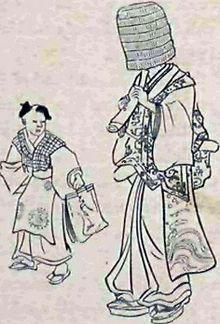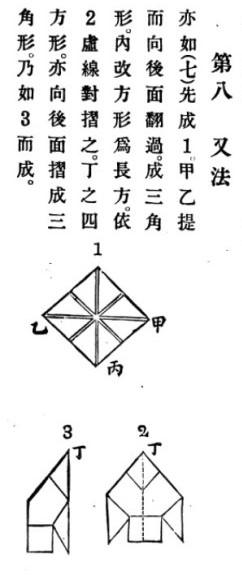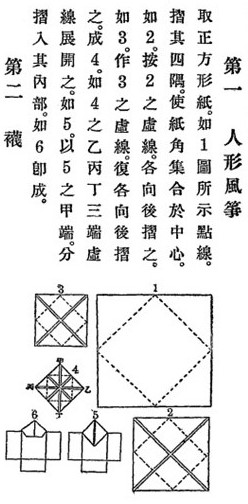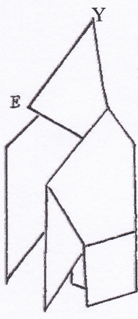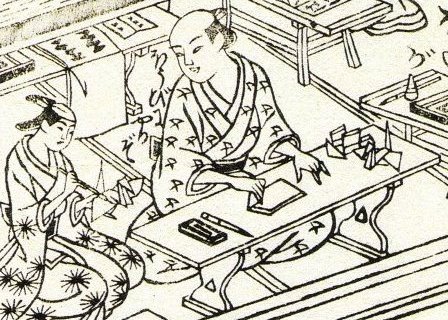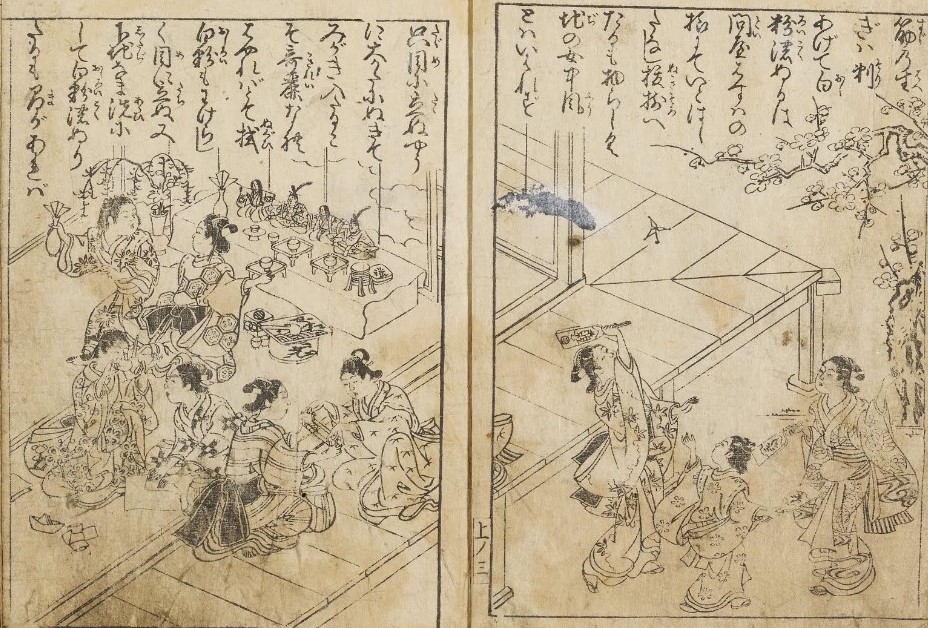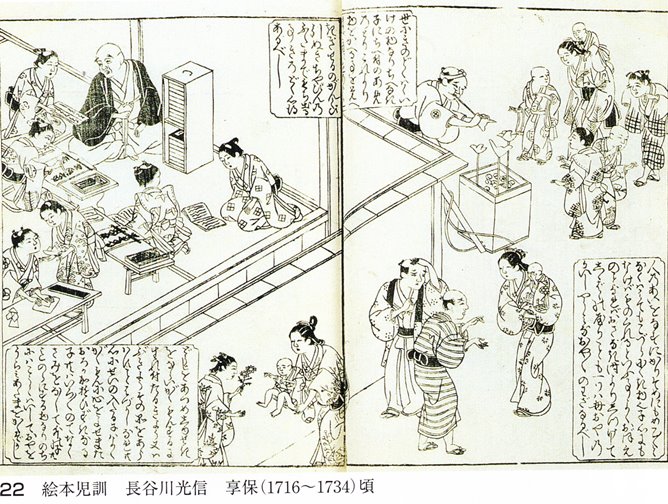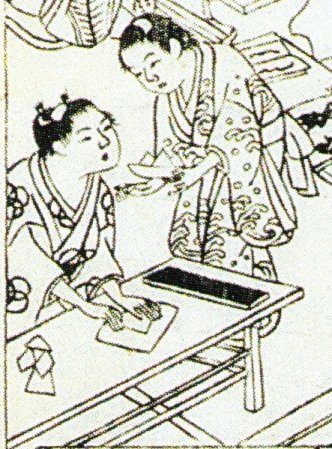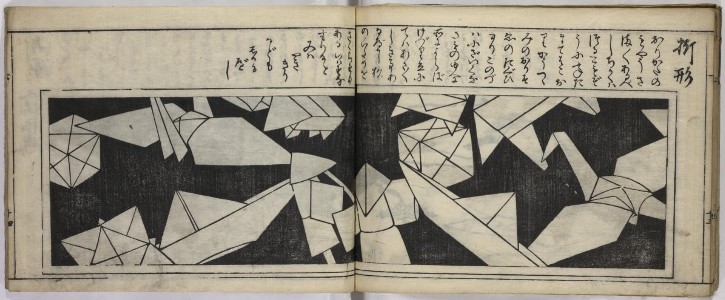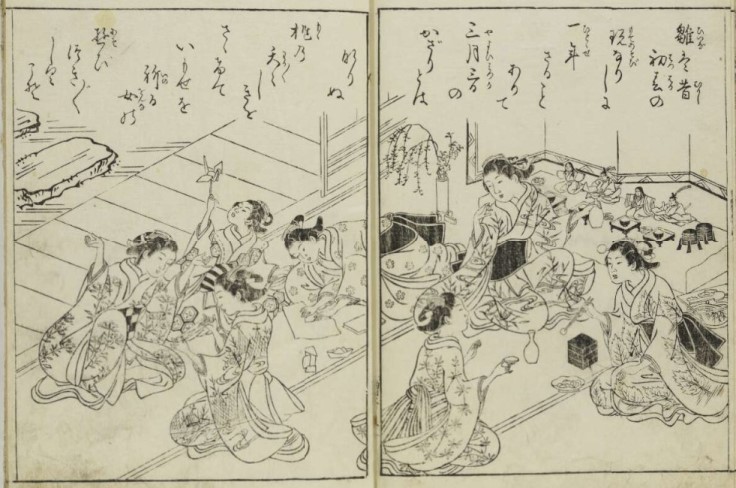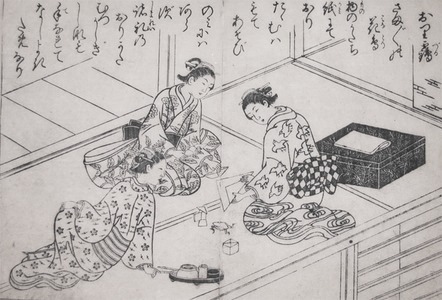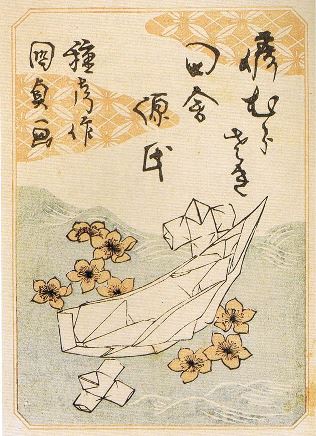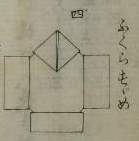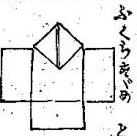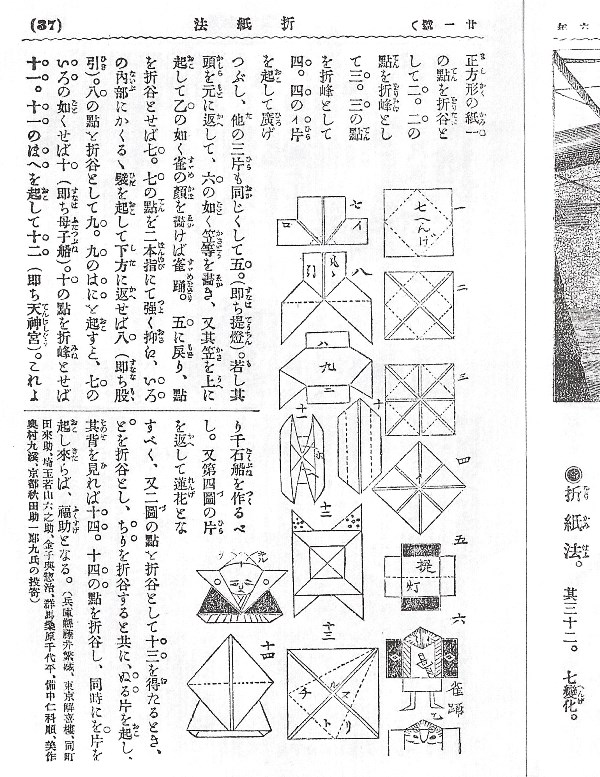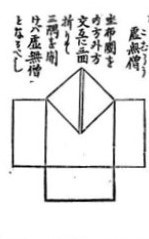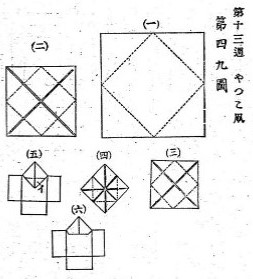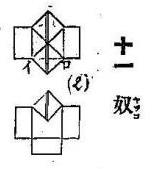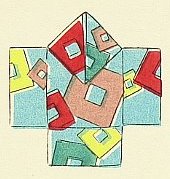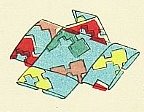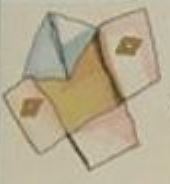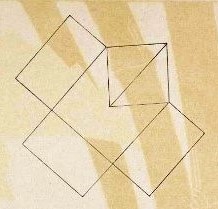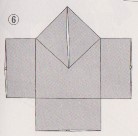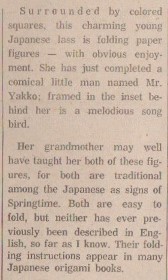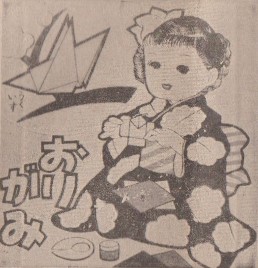| The Public Paperfolding History Project
Last updated 9/1/2024 x |
|||||||
| Komoso / Yakko-san / Fukura Suzume / The Monkey | |||||||
| This page is being used to
collect information about the history of the paperfolding
designs known as Komoso, Yakko-san and Fukura Suzume
(Baby Sparrow). Please contact me if you know any of this
information is incorrect or if you have any other
information that should be added. Thank you. ********** Introduction According to Wikipedia the komoso were a group of Japanese mendicant monks of the Fuke school of Zen Buddhism who flourished during the Edo period of 1600-1868. They were characterized by a straw bascinet (a sedge or reed hood named a tengai or tengui) worn on the head, manifesting the absence of specific ego. They were also known for playing solo pieces on the shakuhachi (a type of Japanese bamboo flute). These pieces, called honkyoku ("original pieces"), were played during a meditative practice called suizen (as opposed to reflective silent meditation) and 'that these monks 'were known first as komoso, which means "straw-hat monk". Later they became known as komuso, which means "priest of nothingness" or "monk of emptiness". The 'hood' of the origami komoso design is presumably a representation of the straw hat that characterised these monks.
********** The relationship between Komoso and Yakko-san is not clear. In older Japanese prints the figure of Komoso does not have the clear cut lines that Yakko-san has in more recent times, in particular having sleeves that are larger and often set at an angle to the body, and it is therefore possible to theorise that the two are essentially unrelated, Komoso being a more complex design from the Edo period and Yakko-san a simpler design developed from Froebel's third groundform in the Japanese kindergarten. Kunihiko Kasahara takes this view n his book 'The Art and Wonder of Origami', an English translation of a work published in Japan in 2004. He suggests that the original Komoso (variously Komusou or Komosou) was superseded by the simpler Yakko-san 'only after Froebel's origami books ... were introduced to Japan.' This could not have happened until after 1876, when the first kindergarten opened in Japan. Nor everyone, however, takes this view. According to Koshiro Hatori in his History of Origami (https://origami.ousaan.com/library/historye.html) 'More familiar origami models such as Orizuru and Yakko-san have been depicted in ukiyoe or patterns for kimono since 18th century. To be accurate, Yakko-san did not exist at that time. They folded it in half and called Komoso.' The only real difficulty in accepting Kasahara's theory lies with the print dated to 1830-42 (see below) which shows a design that appears to be folded, like the later kindergarten design, from a triply blintzed square, except that the sleeves are twice the width they are in later kindergarten version. This may, of course, be an accurate representation of the paperfold or it may be an error on the print designer's part. If it is an error, and the date range assigned to the print is correct (I have not been able to verify this date at present) then this print would be evidence that the version of Yakko-san we are familiar with today was known before the first Japanese kindergarten was founded. Kasahara also notes that 'Some origami documents from the Meiji period depict the Yakko as the Fukura Suzume (Baby Sparrow)' - see entries for 1885 and 1892 below. ********** In China (and in publications by Chinese authors) 1914 Diagrams for Yakko-san, here called a 'Monkey', and a second 'Monkey' design derived from it (pictured on the right below), appear in 'Zhe zhi tu shuo' (Illustrated Paperfolding), compiled by Gui Shaolie, which was published by the Commercial Press in Shanghai in Ming guo 3 (1914).
********** 1917 Yakko-san also appears as 'Human-shaped Kite' in 'Xu Zhe zhi tu shuo' (More Illustrated Paperfolding) by Yongxiang Shi, which was published by the Commercial Press in Shanghai in 1917.
********** 1948 Another version of the second design, also titled 'Monkey', appears in 'The Art of Chinese Paper folding for Young and Old' by Maying Soong, which was published by Harcourt Brace and Company of New York in 1948.
********** In Japan (and in publications by Japanese authors) 1705 In his book 'The Art and Wonder of Origami', Apple Press, 2004, Kunihiko Kasahara states that a drawing of Komoso appeared in 'Contemporary Designs: Models in Detail', probably a kosode pattern book, in 1705. This information is said to come from 'Origami in the Classics' by Satoshi Takagi. ********** 1717 This image from the picture book 'Keisei Ori Tsuru', by an unknown author, show a child being taught origami in a terakoya (a school for the children of commoners). The detail shows the child writing a poem on the wing of one Paper Crane while another Paper Crane and a Komoso lie on the other end of the table. Source: 'Oru Kokoro', the catalogue of an exhibition on paperfolding history held in Tatsuno City History and Culture Museum in 1999.
********** 1723 This print showing a Komoso lying on the floor alongside a Paper Boat comes from 'Onna Fuhzoku Tama kagami' by Nishikawa Sukenobu, which was published in 1723.
********** 1727 The kosode pattern book 'Hinagata ama no hishidate', published in 1727, includes this design featuring the Komoso design. Source: 'Origami koten ni miru origami' Origami in the Classics) by Satoshi Takagi, which was published by the the Yasuhiro Sano, publishing office, Nippon Origami Association, in 1993.
********** 1734 This print from a picture book by Mitsonubo Hasegawa, which can be dated to between 1716 and 1734, shows two children with a Komoso and a Paper Boat with Three Sails in a terakoya (a school for the children of commoners). Source: 'Oru Kokoro', the catalogue of an exhibition on paperfolding history held in Tatsuno City History and Culture Museum in 1999.
********** Komoso also appears in a Japanese book called 'Ranma Zushiki' which dates from 1734. One of these prints shows a group of folded paper objects. Komoso is pictured twice, once folded in half and once flat.
*********** 1748 The print below is from the first volume of the illustrated book 'Ehon masu kagami' by Nishikawa Sukenobu, which was published in 1748. The subject of the print is the Hina Doll Festival and the ladies on the left are folding paper. There is a Komoso lying on the floor. Compare and contrast the similar print from 1723 above. There are a number of other similar prints which also show Komosos, but which I have not yet managed to verify or date. Details of these can be found on the page about Paperfolding in Prints by Nishikawa Sukenobu.
********** 1752 This print, which appears to be by the Japanese print designer Nishikawa Sukenobu (1671-1750), shows women folding paper. Among the designs they have folded is Komoso. In Kunihiko Kasahara's book 'The Art and Wonder of Origami', Apple Press, 2004, he describes a print showing Komoso, the Frog and a cube which is said to come from the book 'Onna-you kyokun ehon hana-no-en', published in 1752. Kasahara does not name the author and I have not been able to verify that this is the print he is describing, although it seems likely that this is the case. If so it must have been published posthumously.
********** 1830-42 This print showing Yakko-san, is said to be by by Kunisada Utigawa (presumably KU1) from 'Nisemurasaki Inaka Genji' and to date from between 1830 and 1842. Source: 'Origami from the Classics' by Satoshi Takagi, published in 1993. (Information from Juan Gimeno.) The blog post Daruma Pilgrims in Japan: Suma and Iro no Hama contains the following information explaining the meaning of this print, which is probably a quotation from the text of 'Nisemurasaki Inaka Genji, although this is not explicitly stated: 'Prince Genji came to exile in Suma and performed a purification ritual upon his arrival there ... Genji had part of the beach separated by a curtain, and called a calendar shaman (onmyooshi ???) to perform the rituals. The shaman put a folded paper doll on a small paper boat and floated it to take away the bad fortune of the prince.' I have no reason to doubt the date given by Takagi for publication of this print but I have not been able to verify it. However, if correctly attributed, it can in any case be no later than 1865 when Kunisada Utigawa died. Also see Introduction above.
********** 1845 There is a note in the 'Kan No Mado', usually dated to 1845, which lists 'komuso' among those designs which are already well known and which are therefore not included in the ms (in order to spare the writer's brush). It seems reasonable to identify this with the Komoso design. ********** In his article 'History of Origami in the East and the West before Interfusion', published in 'Origami 5: Fifth International Meeting of Origami, Science, Mathematics and Education', Koshiro Hatori writes that, 'The origami history researcher Satoshi Takagi one day bought a box containing many origami pieces. They are considered to have been folded by many persons in the house of Moriwaki from the middle eighteenth century through the nineteenth century ... the newer pieces are the traditional models we know well such as the orizuru and yakko-san.' ********** 1885 A picture of Yakkosan, but here called 'fukura suzume' (puffed-up sparrow), appeared in 'Kindergarten Shoho' (Preliminary Kindergarten) by Iijima Hanjuro, which was copyrighted on October 4th Meiji 17 (1884) and published by Fukuda Senzo in August of Meiji 18 (1885).
********** 1892 The design also appears in 'Kani Shukogaku' (Simple Handicraft) by Tamotsu Shibue, which was published in Tokyo in 1892, where it is called a 'fukura suzume' (puffed-up sparrow).'
********** 1894 The same design appears as 'Suzume Odori' (Sparrow Dance) in an article in issue 1894 / 21 of the Japanese children's magazine 'Shokokumin'. The top picture shows the design decorated to create a character wearing a sword and a woven straw hat. The second shows the same design with the head flipped backwards to reveal the face of a sparrow. This may be a representation of a dance that became popular in the early 19th century when a person would dress up like the top picture and then dance mimicking the movements of a sparrow.
********** 1905 A picture of the design appears in 'Shukouka Kyohon : Liron Jishuu Souga Setsumei' by Kikujiro Kiuchi, Rokushiro Uehara and Hideyoshi Okayama, which was published by Shigebei Takase in Chiba in 1905. I am unable to translate the title in this case.
********** The design also appears in 'Shukoka Kyoju Saian' by Gentaro Tanahashi and Hideyoshi Okayama, which was published by Hobunkan in Tokyo in 1905. The hiragana characters at the right say 'Yakko Kite'.
********** 1908 Diagrams that show how to convert the Lantern into Yakko-san (here called the 'General') appear in 'Origami zusetsu' (Illustrated Origami) by Sano Shozo, which was published in Tokyo in 1908.
********** 1912 A drawing of Yakko-san, and another of a closely related design with a different head (on the right), appear in a monozukushi-e print, by an unknown artist, but said to be from the Meiji era. I have temporarily assigned it the date of 1912, the last year of that era, pending the discovery of more accurate information.
********** 1927 A drawing of Yakko-san appears in an illustration by Takei Takeo in a 1927 issue of the children's magazine 'Kodomo No Kuni' (The Land of Children).
********** 1935 'Origami Moyo, Book One', by Kawarazaki Kodo, which was published by Unsodo in Japan in 1935, contains a print showing Yakko san.
********** 1965 This design also appears in 'The World of Origami' by Isao Honda, which was published in the USA by Japan Publications Trading Company in 1965.
********** In Western Europe and the Americas 1968 Vol 8: Issues 1 and 2 of 'The Origamian' for Spring and Summer 1968 contained an article, 'Origami Scrapbook ... Signs of Spring', written by Peter Van Note, about two Japanese designs, one of which was 'Mr. Yakko'.
********** |
|||||||
